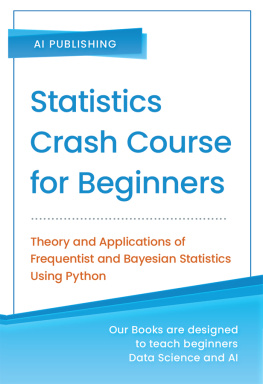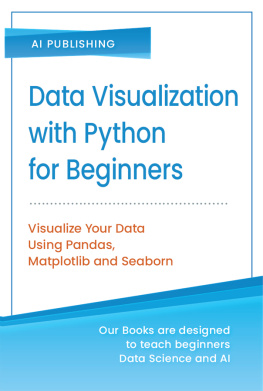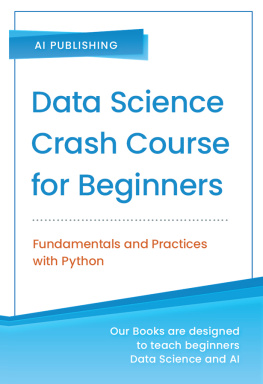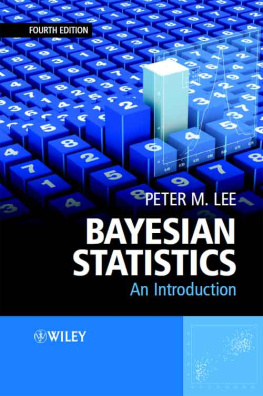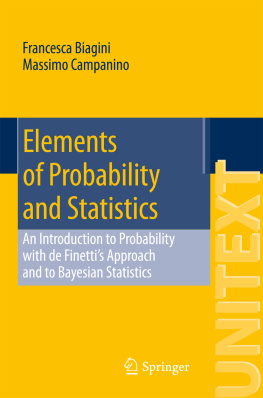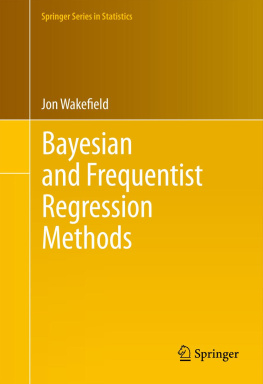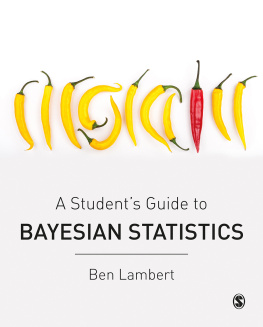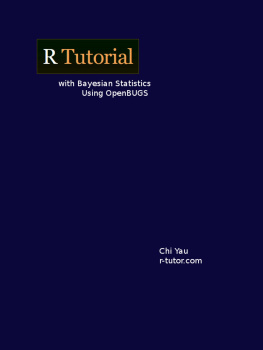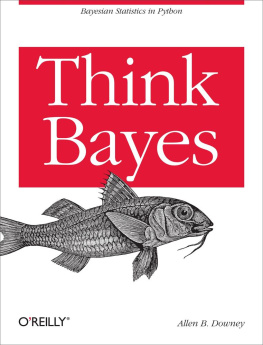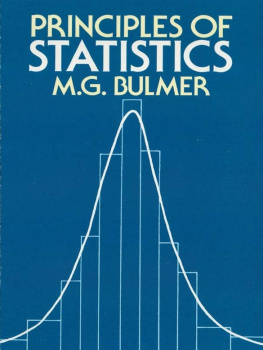AI Publishing - Statistics Crash Course for Beginners: Theory and Applications of Frequentist and Bayesian Statistics Using Python
Here you can read online AI Publishing - Statistics Crash Course for Beginners: Theory and Applications of Frequentist and Bayesian Statistics Using Python full text of the book (entire story) in english for free. Download pdf and epub, get meaning, cover and reviews about this ebook. year: 2020, publisher: AI Publishing, genre: Science. Description of the work, (preface) as well as reviews are available. Best literature library LitArk.com created for fans of good reading and offers a wide selection of genres:
Romance novel
Science fiction
Adventure
Detective
Science
History
Home and family
Prose
Art
Politics
Computer
Non-fiction
Religion
Business
Children
Humor
Choose a favorite category and find really read worthwhile books. Enjoy immersion in the world of imagination, feel the emotions of the characters or learn something new for yourself, make an fascinating discovery.
- Book:Statistics Crash Course for Beginners: Theory and Applications of Frequentist and Bayesian Statistics Using Python
- Author:
- Publisher:AI Publishing
- Genre:
- Year:2020
- Rating:4 / 5
- Favourites:Add to favourites
- Your mark:
- 80
- 1
- 2
- 3
- 4
- 5
Statistics Crash Course for Beginners: Theory and Applications of Frequentist and Bayesian Statistics Using Python: summary, description and annotation
We offer to read an annotation, description, summary or preface (depends on what the author of the book "Statistics Crash Course for Beginners: Theory and Applications of Frequentist and Bayesian Statistics Using Python" wrote himself). If you haven't found the necessary information about the book — write in the comments, we will try to find it.
AI Publishing: author's other books
Who wrote Statistics Crash Course for Beginners: Theory and Applications of Frequentist and Bayesian Statistics Using Python? Find out the surname, the name of the author of the book and a list of all author's works by series.
Statistics Crash Course for Beginners: Theory and Applications of Frequentist and Bayesian Statistics Using Python — read online for free the complete book (whole text) full work
Below is the text of the book, divided by pages. System saving the place of the last page read, allows you to conveniently read the book "Statistics Crash Course for Beginners: Theory and Applications of Frequentist and Bayesian Statistics Using Python" online for free, without having to search again every time where you left off. Put a bookmark, and you can go to the page where you finished reading at any time.
Font size:
Interval:
Bookmark:

Copyright 2020 by AI Publishing
All rights reserved.
First Printing, 2020
Edited by AI Publishing
eBook Converted and Cover by Gazler Studio
Published by AI Publishing LLC
ISBN-13: 978-1-7347901-6-0
The contents of this book may not be copied, reproduced, duplicated, or transmitted without the direct written permission of the author. Under no circumstances whatsoever will any legal liability or blame be held against the publisher for any compensation, damages, or monetary loss due to the information contained herein, either directly or indirectly.
Legal Notice:
You are not permitted to amend, use, distribute, sell, quote, or paraphrase any part of the content within this book without the specific consent of the author.
Disclaimer Notice:
Kindly note that the information contained within this document is solely for educational and entertainment purposes. No warranties of any kind are indicated or expressed. Readers accept that the author is not providing any legal, professional, financial, or medical advice. Kindly consult a licensed professional before trying out any techniques explained in this book.
By reading this document, the reader consents that under no circumstances is the author liable for any losses, direct or indirect, that are incurred as a consequence of the use of the information contained within this document, including, but not restricted to, errors, omissions, or inaccuracies.
How to Contact Us
If you have any feedback, please let us know by sending an email to .
Your feedback is immensely valued, and we look forward to hearing from you.
It will be beneficial for us to improve the quality of our books.
To get the Python codes and materials used in this book, please click the link below:
https://www.aispublishing.net/book-sccb
The order number is required.
About the Publisher
At AI Publishing Company, we have established an international learning platform specifically for young students, beginners, small enterprises, startups, and managers who are new to data science and artificial intelligence.
Through our interactive, coherent, and practical books and courses, we help beginners learn skills that are crucial to developing AI and data science projects.
Our courses and books range from basic introduction courses to language programming and data science to advanced courses for machine learning, deep learning, computer vision, big data, and much more. The programming languages used include Python, R, and some data science and AI software.
AI Publishings core focus is to enable our learners to create and try proactive solutions for digital problems by leveraging the power of AI and data science to the maximum extent.
Moreover, we offer specialized assistance in the form of our online content and eBooks, providing up-to-date and useful insight into AI practices and data science subjects, along with eliminating the doubts and misconceptions about AI and programming.
Our experts have cautiously developed our contents and kept them concise, short, and comprehensive so that you can understand everything clearly and effectively and start practicing the applications right away.
We also offer consultancy and corporate training in AI and data science for enterprises so that their staff can navigate through the workflow efficiently.
With AI Publishing, you can always stay closer to the innovative world of AI and data science.
If you are eager to learn the A to Z of AI and data science but have no clue where to start, AI Publishing is the finest place to go.
Please contact us by email at
AI Publishing is Looking for Authors Like You
Interested in becoming an author for AI Publishing? Please contact us at
We are working with developers and AI tech professionals just like you, to help them share their insights with the global AI and Data Science lovers. You can share all your knowledge about hot topics in AI and Data Science.
Table of Contents
Preface
The fields of Artificial Intelligence (AI), Machine Learning (ML), and Data Science (DS) are prevailing in many real-world applications. A crucial part of these fields is to deal with a huge amount of data, which is produced at an unprecedented rate nowadays. This data is used to extract useful information for making future predictions on unseen but similar kinds of data.
Statistics is the field that lies at the core of Artificial Intelligence, Machine Learning, and Data Science. Statistics is concerned with collecting, analyzing, and understanding data. It aims to develop models that are able to make decisions in the presence of uncertainty. Numerous techniques of the aforementioned fields make use of statistics. Thus, it is essential to gain knowledge of statistics to be able to design intelligent systems.
This book is dedicated to the techniques for frequentist and Bayesian statistics. These two types of statistical techniques interpret the concept of probability in different ways.
According to the frequentist approach, the probability of an event is defined for the repeatable events whose outcomes are random. The statistical experiment is run again and again in a long run to get the probability of the event. Thus, the probability of an event equals the long-term frequency of occurrence of that event.
For example, rolling a six-sided dice can be considered a repeatable statistical experiment. The outcome of this experiment can be any number from 1 to 6. Since we do not know what will be the outcome in a particular rolling of the dice, we call it a random outcome. According to the frequentist approach, the chance of getting any particular number from 1 to 6 is equally likely. In other words, the probability of any number is 1/6 or 1 out of 6.
As another example, in a pack of 52 cards, we randomly draw a card. We want to check the chance of getting a king. To find the probability of our defined event, i.e., getting a king, we count the number of favorable outcomes: 4 out of 52 cards. Thus, the probability of getting a king is obtained by dividing the number of favorable outcomes by the total number of possible outcomes: 4/52 = 1/13.
The frequentist way of doing statistics makes use of the data from the current experiment. However, contrary to the frequentist approach, the Bayesian approach interprets probability as a degree of belief. For example, it is believed from some previous experiments that a head is twice as likely to occur than a tail. Now, the probability of having a head would be 2/3 as compared to the probability of getting a tail, i.e., 1/3. This belief before running the experiment is our prior belief about the experiment of tossing a coin.
The belief can increase, decrease, or even remain the same if we run this experiment again and again. This example shows that the Bayesian interpretation of probability makes use of previous runs of the experiment to have a degree of belief about any particular experiment. We shall go into the details of these concepts in subsequent chapters of the book.
This book intends to teach beginners the concepts of statistics using the Python programming language. After completing the book, the readers will learn how to collect, sample, manipulate, and analyze data. They will also perform experiments to explore and visualize a given dataset. The book aims to introduce to the reader the techniques for estimation and inference of valuable parameters of the statistical models.
Next pageFont size:
Interval:
Bookmark:
Similar books «Statistics Crash Course for Beginners: Theory and Applications of Frequentist and Bayesian Statistics Using Python»
Look at similar books to Statistics Crash Course for Beginners: Theory and Applications of Frequentist and Bayesian Statistics Using Python. We have selected literature similar in name and meaning in the hope of providing readers with more options to find new, interesting, not yet read works.
Discussion, reviews of the book Statistics Crash Course for Beginners: Theory and Applications of Frequentist and Bayesian Statistics Using Python and just readers' own opinions. Leave your comments, write what you think about the work, its meaning or the main characters. Specify what exactly you liked and what you didn't like, and why you think so.

